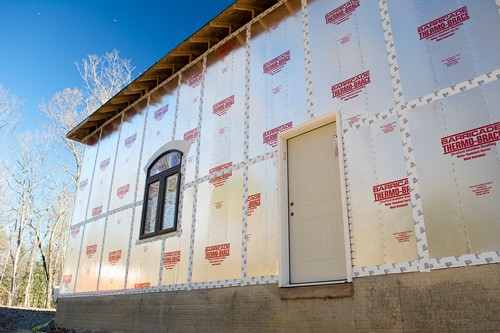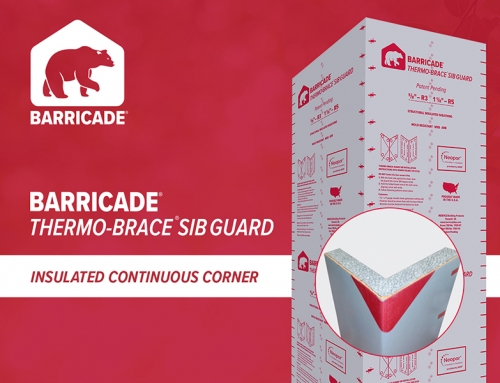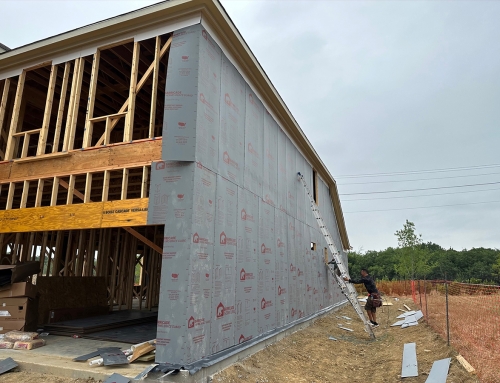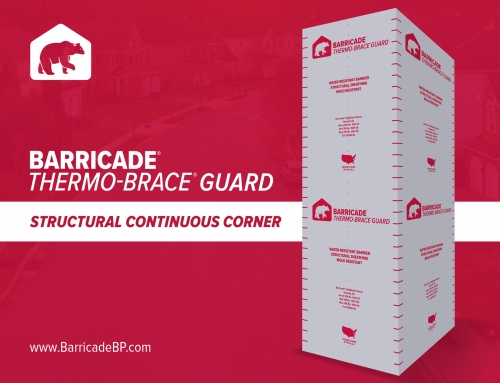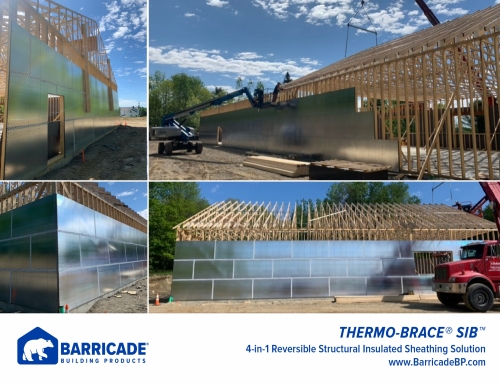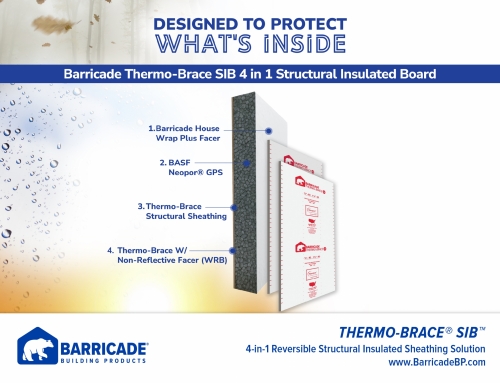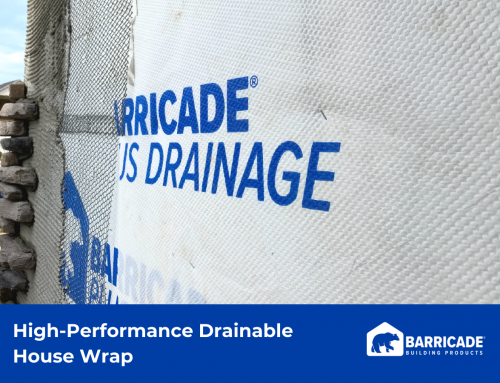A weather-resistant barrier (WRB) is an important part of today’s energy-efficient and healthy homes and commercial buildings. A modern WRB design shields the walls of a structure from water and air infiltration, along with moisture accumulation within the wall systems.
The need for WRB emerged during the end of the late 20th century when growing environmental concerns and rising fuel costs prompted the need for more energy-efficient structures with tight building envelopes. Initial designs of WRB were airtight but not permeable; therefore, moisture became trapped in the walls, which led to mold and rot. Consequently, it became clear that WRBs needed to be vapor permeable. Vapor-permeable WRBs would let water escape from the wall system and protect a building or home from damage and deterioration.
Modern, high-quality weather-resistant barriers are both air- and moisture-resistant and permeable to vapor, which ensures a home or commercial building is energy-efficient, healthy and comfortable.
Weather-resistant barriers are the second line of defense against moisture entering a building or home. The wall cladding is the first line of defense. The American Architectural Manufacturers Association (AAMA) defines a weather-resistant barrier as a surface or a wall responsible for preventing air and water infiltration to the building’s interior. Weather-resistant barriers should not be confused with water-resistant barriers. Water-resistant barriers provide only a continuous water-resistant barrier behind the exterior wall veneer. There are several categories of weather-resistant barriers including asphalt-felt, Grade D building paper, and plastic house wrap.
- Asphalt felt (tar paper) has a perm rating of approximately 5. It can block water on a vertical wall, which makes it a useful sheathing wrap. Recycled cardboard and sawdust are used to make asphalt felt paper, rather than traditional cotton rags. The problem with asphalt felt is it deteriorates under prolonged exposure to UV and tears easily.
- Grade D building paper is an asphalt-impregnated reinforced paper with perm ratings of about 5. Grade D paper is commonly under stucco in the western United States. The problem with Grade D paper is it will deteriorate when wet for extended periods of time.
- Plastic house wraps are synthetic sheathing wraps that are airtight with perm ratings of 9 to 50.
A high-quality weather-resistant barrier should be air- and moisture-resistant, permeable, with high tear strength and UV-resistant. It should also be simple to install. Importantly, a weather-resistant barrier must meet the 2018 International Building Codes (IBC 1402.2) requirements for water-resistance, along with vapor permeability and the 2018 International Residential Code for water resistance (IRC R703.1.1)2.
Barricade® Building Wrap is a high performing weather-resistant barrier that meets and exceeds the requirements of the IBC 1402.2 and IRC R703.1.1. It is air- and moisture-resistant, permeable, UV-resistant, and has high tear strength. It is also easy to install.
The high levels of air resistance of the Barricade Building Wraps are in accordance with IRC Section N1102.4.1 and IECC Section 402.4 and 502.4.
Barricade Building Wraps pass all the tests used to measure a house wrap’s water resistance: ASTM D779 (boat test), CCMC 07102 (pond test), and AATCC Test Method 127.
The five Barricade Building Wraps are permeable to vapor. The ASTM E96 standard requires house wrap with five perms or greater. The higher the number, the more permeable the material.
ALL FIVE BARRICADE BUILDING WRAPS ACHIEVE GREATER THAN FIVE PERMS.
- Barricade Building Wrap – Permeability (ASTM E-96A): 11 perms
- Barricade Plus™ House Wrap – Permeability (ASTM E-96A): 16 perms
- R-Wrap Protective House Wrap – Permeability (ASTM E-96A): 50 perms
The maximum time a house wrap can endure exposure from the sun before becoming damaged is an important element of a house wrap.
BARRICADE BUILDING WRAPS CAN WITHSTAND BETWEEN FOUR MONTHS AND ONE YEAR OF UV-EXPOSURE WITHOUT DAMAGE OCCURRING.
- Barricade® Building Wrap – UV exposure of 12 months
- Barricade® Plus™ House Wrap – UV exposure of 9 months
- R-Wrap® Protective House Wrap – UV exposure of 9 months
A WRB with high resistance to tearing is essential to the successful installation of a weather-resistant barrier.
BARRICADE BUILDING WRAP HAS A TEAR-STOP DESIGN WITH EXCELLENT STRENGTH.
- Barricade Building Wrap – tensile strength (ASTM D-5034) of 63.3 lbs/inch MD, 51.4 lbs/inch CD
- Barricade Plus™ House Wrap – tensile strength (ASTM D-5034) of 59 lbs/inch MD, 51lbs/inch CD
- R-Wrap® Protective House Wrap – tensile strength (ASTM D-5034) of 59 lbs/inch MD, 51lbs/inch CD
Barricade Building Wraps are high-performing, effective weather-resistant wraps. Weather-resistant wraps are important for creating energy-efficient, durable, and healthy commercial buildings and homes. Please visit Barricade for more information on the importance of weather-resistant barriers.
1The IBC 140.2 states that exterior walls shall provide the building with a weather-resistant exterior wall envelope, including a manner to stop water from accumulating within the wall assembly by providing a water-resistive barrier behind the exterior veneer.
2The 2018 IRC R703.1.1 requires that the exterior wall envelope shall be designed and constructed in a manner that prevents the accumulation of water within the wall assembly by providing a water-resistant barrier behind the exterior veneer as required by Section R703.2 and a means of draining to the exterior water that enters the assembly.

